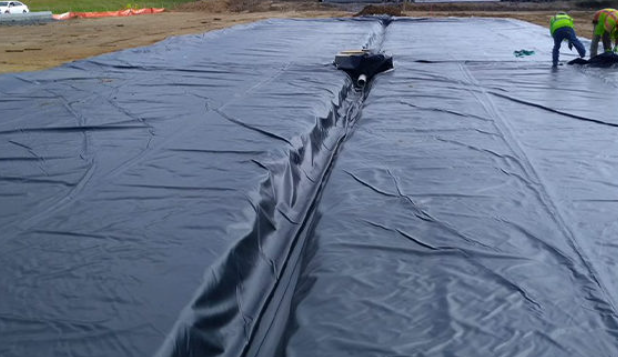- Understanding the Role of Geomembrane Liners in Waste Management
- Innovations in Geomembrane Liners for Water Management
- Geomembrane Liners: A Comprehensive Guide
- The Future of Geomembrane Liners in Civil Engineering
- Geomembrane Liners: Enhancing Landfill Stability
Manager:Alvin Wang
WhatsApp:+62 8983806051
Tel:+86 10-5797-1075
Email:steelwang@okorder.com
Address:3rd Floor, No.2 Building, No.1 Sanlihe Road
The Difference Between Geomembrane and Plastic Film
In the field of civil engineering, environmental protection, and construction, materials like geomembrane and plastic film play crucial roles. While both are employed for containment and protection purposes, they differ significantly in their composition, applications, and characteristics. This article explores the differences between geomembrane and plastic film, providing a comprehensive understanding of their respective roles and benefits.

What is a Geomembrane?
Geomembranes are synthetic membranes typically made from materials such as high-density polyethylene (HDPE), linear low-density polyethylene (LLDPE), polyvinyl chloride (PVC), and ethylene propylene diene monomer (EPDM). These materials are engineered to be impermeable, ensuring that they effectively contain liquids or gases, preventing their migration into surrounding areas. Geomembranes are widely used in a variety of applications, including landfill liners, wastewater treatment ponds, mining operations, and agricultural ponds.
Characteristics of Geomembranes
1. Impermeability: One of the primary characteristics of geomembranes is their low permeability, which ensures that liquids and gases do not pass through them. This makes them ideal for containment applications.
2. Durability: Geomembranes are designed to withstand harsh environmental conditions. They are resistant to chemicals, ultraviolet (UV) radiation, and physical damage, which ensures their longevity and reliability.
3. Flexibility: While geomembranes are robust, they also offer a degree of flexibility that allows them to conform to the underlying surfaces and accommodate ground movements without compromising their integrity.
4. Thickness and Composition: Geomembranes are generally thicker than typical plastic films, often ranging from 0.5 mm to 3 mm or more. This thickness contributes to their strength and impermeability.
Applications of Geomembranes
1. Landfill Liners and Caps: Geomembranes are extensively used in landfills to prevent leachate from contaminating groundwater. They are used both as liners at the base of landfills and as caps to cover the top once the landfill is full.
2. Mining: In mining operations, geomembranes are used to line heap leach pads, tailing ponds, and containment ponds. They prevent the escape of hazardous chemicals into the environment.
3. Water and Wastewater Treatment: Geomembranes are used in the construction of ponds and lagoons for the containment of water and wastewater. They ensure that the contents do not seep into the ground, protecting groundwater quality.
4. Agriculture: Geomembranes are used to line irrigation canals, reservoirs, and ponds in agricultural settings. They help in water conservation by preventing seepage.
What is a Plastic Film?
Plastic films, on the other hand, are thin sheets of plastic material that are commonly used for packaging, covering, and protecting goods. Plastic films are typically made from polyethylene (PE), polyvinyl chloride (PVC), polypropylene (PP), and other similar materials. They are widely used in both industrial and consumer applications due to their versatility and cost-effectiveness.
Characteristics of Plastic Films
1. Versatility: Plastic films are highly versatile and can be used in a variety of applications, from packaging and wrapping to agricultural covers and liners.
2. Flexibility and Thinness: Plastic films are usually much thinner than geomembranes, often ranging from a few micrometers to a few millimeters in thickness. This thinness allows them to be easily manipulated and applied in different contexts.
3. Transparency: Many plastic films are transparent or translucent, making them suitable for applications where visibility is important, such as packaging and greenhouse covers.
4. Cost-Effectiveness: Plastic films are generally less expensive than geomembranes due to their simpler manufacturing process and the lower cost of raw materials.
Applications of Plastic Films
1. Packaging: Plastic films are extensively used in the packaging industry for wrapping food, consumer goods, and industrial products. Their flexibility and transparency make them ideal for this purpose.
2. Agriculture: In agriculture, plastic films are used as mulch films, greenhouse covers, and silage bags. These films help in controlling the microenvironment for plants, conserving moisture, and protecting crops from pests and weather conditions.
3. Construction: Plastic films are used as vapor barriers in construction to prevent moisture from penetrating walls and floors. They are also used as temporary coverings during construction projects.
4. Consumer Products: Many everyday items, such as garbage bags, plastic liners, and protective covers, are made from plastic films. Their convenience and cost-effectiveness make them a staple in households and businesses.
Key Differences Between Geomembrane and Plastic Film
1. Purpose and Application
The most significant difference between geomembranes and plastic films lies in their primary purpose and application. Geomembranes are specifically engineered for environmental protection and containment applications, such as lining landfills, ponds, and mining facilities. Their design focuses on impermeability, chemical resistance, and durability.
Plastic films, on the other hand, are designed for versatility and cost-effectiveness in packaging, covering, and protecting various goods. Their applications are broader and less specialized compared to geomembranes, ranging from food packaging to agricultural covers.
2. Material Composition and Thickness
Geomembranes are generally made from more robust and thicker materials such as HDPE, LLDPE, and PVC. Their thickness typically ranges from 0.5 mm to 3 mm or more, providing the necessary strength and impermeability for containment applications.
Plastic films are thinner and more flexible, with thicknesses ranging from a few micrometers to a few millimeters. They are made from materials like polyethylene, which are less robust but more versatile and easier to produce.
3. Durability and Resistance
Geomembranes are designed to withstand harsh environmental conditions, including exposure to UV radiation, chemicals, and physical stresses. They are built to last for decades in challenging conditions, providing reliable containment and protection.
Plastic films, while durable for their intended purposes, do not offer the same level of resistance to environmental factors as geomembranes. They are more susceptible to degradation from UV exposure and chemical interactions, making them less suitable for long-term containment applications.
4. Cost and Production
The production of geomembranes involves more complex processes and higher-quality materials, which contributes to their higher cost compared to plastic films. The added durability and performance characteristics justify the investment for specialized applications where containment and environmental protection are critical.
Plastic films are more cost-effective due to their simpler manufacturing processes and lower material costs. Their affordability makes them ideal for widespread use in packaging, agriculture, and consumer products.

Conclusion
In summary, while both geomembranes and plastic films serve important roles in various industries, their differences in composition, thickness, durability, and application make them suitable for distinct purposes. Geomembranes, with their impermeability and durability, are essential for environmental containment and protection projects. Plastic films, with their versatility and cost-effectiveness, are indispensable in packaging, agriculture, and consumer goods. Understanding these differences ensures that the right material is chosen for each specific application, maximizing efficiency, and effectiveness.
-
2024-12-05Geomembrane Liners: A Comprehensive Guide






